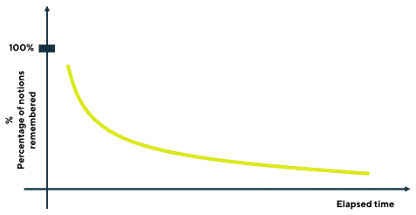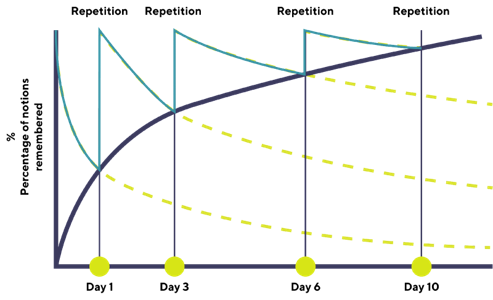How the spaced learning method helps workers to learn new concepts and remember them over time.
Spaced learning is the principle by which information is more easily assimilated if provided at regular intervals repeated over time. “Spaced” – from the English “to space” – means spaced out, distributed, hence a learning method that divides a single lesson into several fragmented moments. Science recommends spaced learning, specifically the research by neurologist Paul Kelley, who has dedicated his career to studying the functioning of long-term memory both in humans and in other species (“Frontiers in Human Neuroscience”1 of 2013). This approach was applied to educational itineraries, then integrated with company training thanks to digital formats and hybrid methods, bringing excellent results.
Why is spaced learning effective?
Memory tends to fade quickly if not strengthened and retrieved at regular intervals. In other words, effective long-term learning is rarely achieved in a single event. The reason is that we not only have a “learning curve” (where individuals learn over time), but we also have a “forgetting curve” (where we gradually lose what we have learned if not used).

This is especially true when workers learn in a work context where their mind is filled with a thousand other commitments. Without practice and exercise the new concepts will soon be forgotten. So, what’s to be done?
Imagine a practical case. If your learners take 30 minutes to study a particular topic, it will be more effective for their memory to divide that time into three short sessions of 10 minutes rather than learning everything together.

How to create the “spaced” effect
The priority of corporate spaced learning is to ensure not only that new concepts and behaviors are assimilated by the worker, but that they are remembered in the long term thanks to repetition at intervals over time. To create the so-called “spaced” effect, two strategies can be adopted:
- Introduce an extended interval between two or more repetitions. Learners will be introduced to a concept, let some time pass, then be re-presented with the same concept. The cycle could include several spaced-out repetitions depending on the complexity of the topic.
- Present other topics between two or more repetitions. You can vary the topics to be studied and review them at different stages, rather than tackling them all at the same time. This way the learner will have time to process the various concepts and build the right mental connections between them.
Introduce spaced learning into training courses
Creating spaced learning sessions on certain topics is therefore not complicated, but how do we integrate spaced learning into a more structured training path? Let’s see the user strategies for more complex learning paths:
- Integrate spaced learning into the course design. The structure of the contents, the duration of each module, and the suggested interval between each repetition must be planned when designing the course.
- Combine micro-learning and macro-learning according to the needs and objectives of each module. One of the best ways is undoubtedly to use a hybrid approach that ensures new concepts that need time to be studied (macro-learning) can be assimilated thanks to repetition over time. This can be combined with short and concise refresher modules (micro-learning) such as exercises, case studies, quizzes or interactive scenarios.
- Using Storytelling. Stories are a perfect way to connect various pieces of information in a coherent and easy-to-remember flow. This approach can be applied either to the entire learning itinerary or to a single macro-module. Easy-to-recognize characters can be designed for learners to identify with, perhaps creating suspense between one piece of content and another. Storytelling also has the double advantage of supporting structured content by bringing involvement and interest in the story.
In summary
Spaced learning has many advantages and can be integrated into our learning itineraries. Giving workers extra time to process concepts will also guarantee more effectiveness in assimilating and using such information on a daily work basis. Give space and value your employees’ “learning curve”, but also be aware of their “forgetting curve.”
References
P. Kelly (2013). Making long-term memories in minutes: a spaced learning pattern from memory research in education. Frontiers in Human Neuroscience.


